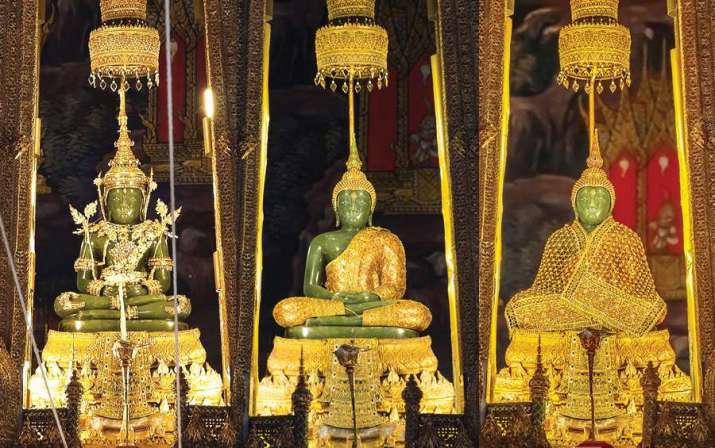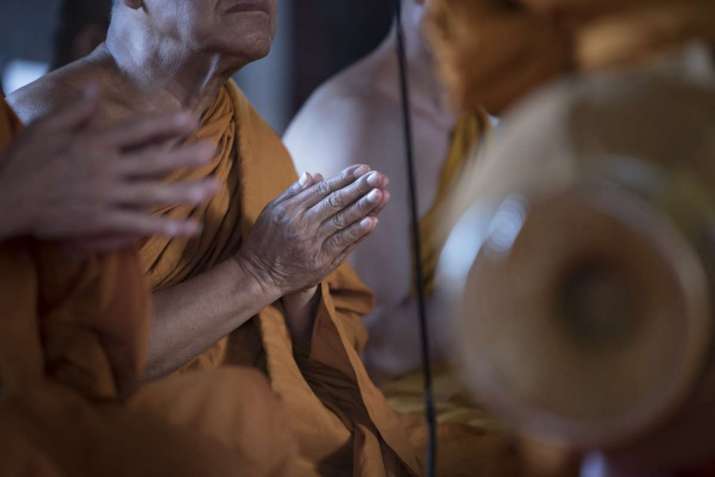FEATURES|COLUMNS|Academic Reflections
Tales of the Emerald Buddha: Simplicity and Splendor
 The Emerald Buddha at Wat Phra Kaeo, in Bangkok’s Grand Palace. The king changes its golden garments for each of the three seasons, from left to right: hot season, rainy season, and cool season. From btbangkok.com
The Emerald Buddha at Wat Phra Kaeo, in Bangkok’s Grand Palace. The king changes its golden garments for each of the three seasons, from left to right: hot season, rainy season, and cool season. From btbangkok.comI was giving a lecture on the Buddha’s hagiography when it happened.
I had gotten carried away with my descriptions of giant mandarava flowers falling from the sky and jeweled walkways spanning the lengths of the universe when a student’s hand shot into the air.
“I don’t understand how you can be saying all this,” she blurted out impatiently.
“Saying what?”
“All of this . . . elaborateness. How can you describe Buddhism this way? I thought it was supposed to be austere.”
And there it was; that recurring expectation. The assumption that Buddhism is supposed to be the embodiment of simplicity, renunciation, and . . . austerity. How did we get here? I wondered to myself.
I thought back to the moment when this very paradox became obvious to me. It was a few years earlier in Bangkok, during a summer trip. Rivulets of sweat were running down my back as I dragged myself through the streets toward the Grand Palace. I was so excited to meet the Emerald Buddha that I was willing to push through the sweltering heat.
Gilded buildings, shining stupas, spectacular gardens spilling in all directions—it was just as magnificent as the books promised it would be. I remember one section dedicated entirely to paintings of the Ramayana. I must have spent an hour going over it, drinking in the mastery of it all. Tourists pushed their way around me with their cameras, chasing each other and their guidebooks, but I would not be rushed. The paintings demanded recognition.
I slipped off my sandals as I entered a temple inside the grounds of the Grand Palace. I had no idea where I was, so overwhelmed by the grandeur and magnificence of it all. I looked up . . . and was dazzled! There was so much shining, glittering bling in every direction, I had an inclination to take out my sunglasses! Golden images, golden deities, golden guardians, and an extremely elaborate golden altar filled the room. Everything was made of gold! And high up near the ceiling, just below the sparkling chandeliers, sat a small green object bedecked in gold, on a golden pedestal.
I wasn’t sure about what I was looking at, but I knew that I needed to catch my breath and sit down for a moment. To find a way to take it in. Eventually, I turned to the woman sitting next to me.
“Excuse me,” I said. “What temple is this?”
She rolled her eyes and returned her focus to the image near the ceiling.
I wondered. Could it be? But it’s so small!
The woman on the other side of me nudged me. “That’s the Emerald Buddha,” she whispered.
This is the place, I marveled to myself. I looked up again and felt my entire body exhale. The Emerald Buddha was right above me. After all this time, we finally meet.
I spent a long time sitting at the Emerald Buddha’s feet. People came and went, guards paced, fans whirled, but I would not move. I had waited a long time to see it.
There are so many things to be said about this image—about its origin stories, its magical powers, its history. Chronicles claim that it can distinguish worshippers with pure intentions from those without, making the light shine more brightly when pure-hearted worshippers approach. Other texts claim that it helped cure a cholera outbreak in the 19th century, and that it stalled an elephant in its tracks. That the jewel it was fashioned from was found on a magical mountain and retrieved by the gods. But in that moment, all I could process was its extraordinary glitter. The fabulousness of Buddhism that seemed to be encapsulated in that moment of time and space.
 Buddhism can be simplicity incarnate, but it is also lavish, fabulous, and proud. Photo by Arisa Chattasa
Buddhism can be simplicity incarnate, but it is also lavish, fabulous, and proud. Photo by Arisa ChattasaMy student expected Buddhism to be austere. She imagined monastic robes and shaved heads, simplicity and non-attachment. Not golden spires and baskets full of jewels. And yet here it was—more glitter than Beyonce is capable of conjuring on stage, and all of it under the auspices of Buddhist traditionalism.
My student was not wrong to expect austerity. Much of Buddhist doctrine is focused on renunciation and non-attachment. Its central narrative is about a prince who abandoned his kingdom for a life of wandering homelessness. Who chose the forest instead of his throne. But she was wrong to assume that doctrine told the whole story. Buddhism can be simplicity incarnate, but it is also lavish, fabulous, and proud. Buddha statues are lovingly adorned with gold leaf in Buddhist temples throughout Southeast Asia, monasteries showcase their most valuable images on pedestals of gold, jewels are often encased with relics inside important sites of worship.
Although Buddhism can be understated, it can also strut like a peacock, and the Emerald Buddha is a perfect case in point. Buddhism is much more than its doctrine. It is also about bling. That too is part of the story. A story we should marvel at and enjoy.
Related features from Buddhistdoor Global
Sri Lanka International Buddhist Academy: A Visionary Institution for a Traditional Buddhist Land
The Ten Powers of the Tathāgata
Buddhistdoor View: Reflections on the Controversies in the Thai Buddhist Monastic Order














